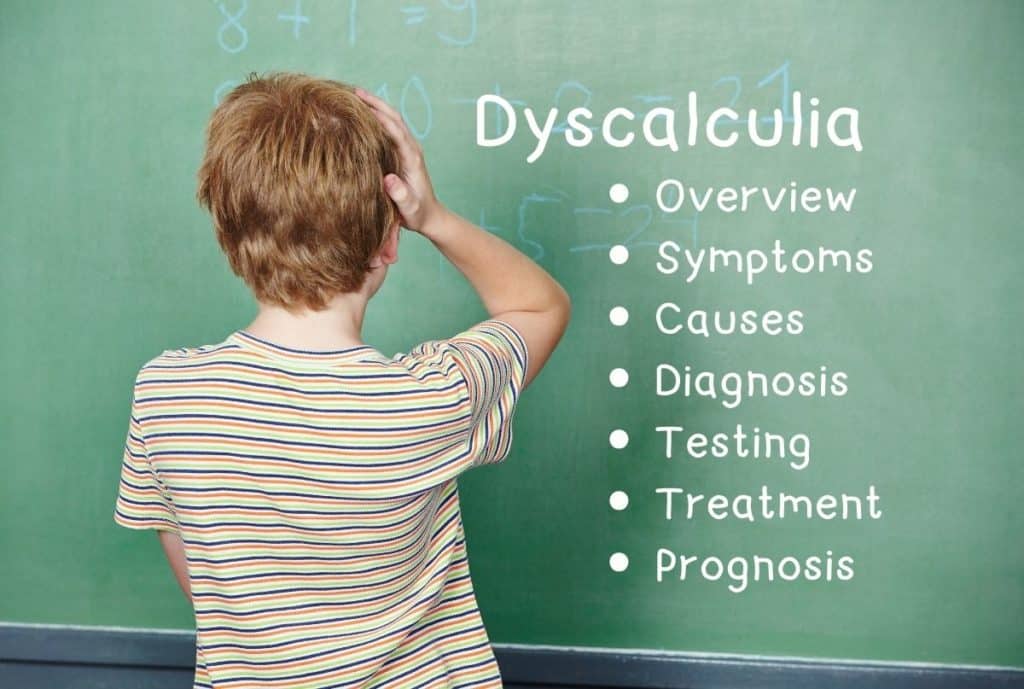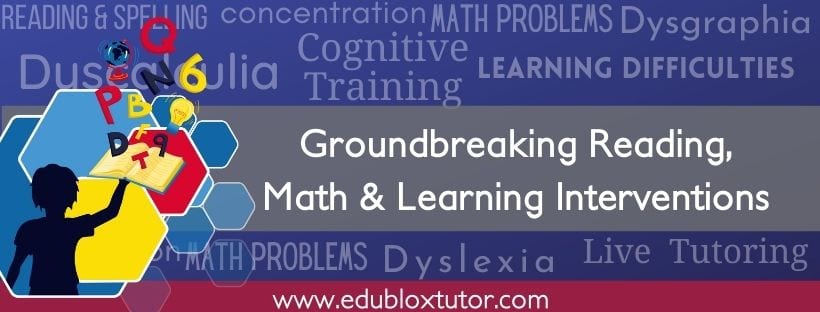
Dyscalculia refers to a wide range of persistent and extreme difficulties in math, including weaknesses in understanding the meaning of numbers and difficulty applying mathematical principles to solve problems.
Dyscalculia differs from the ordinary experience of “being bad at math.” For example, many students may find trigonometry difficult. Children with dyscalculia, however, may be unable to solve simple problems such as 7+2 or 5×3.
Table of contents:
Overview
What is dyscalculia?
The term developmental dyscalculia may be used to distinguish the problem in children and youth from similar issues experienced by persons after experiencing certain medical conditions. Developmental dyscalculia is a specific learning difficulty manifested by failure to achieve adequate proficiency in arithmetic despite normal intelligence, sufficient scholastic opportunities, emotional stability, and sufficient motivation.
Acalculia or acquired dyscalculia is a type of dyscalculia that can happen at any age due to a medical condition (see below).
Students with pseudo-dyscalculia have severe math anxiety and may even develop math phobia (arithmophobia). Those who have been supported to overcome their math anxiety will potentially be able to function very well in math. However, because of their difficulties with math, most dyscalculics have some anxiety about math (Hornigold, 2015).
What is the difference between dyscalculia and dyslexia?
Dyscalculia and dyslexia are both learning disabilities, but they have fundamental differences:
- Dyscalculia is a learning disability affecting a person’s ability to do math.
- Dyslexia is a learning disability affecting a person’s ability to read.
While different, both are termed a “specific learning disorder” according to the Diagnostic and Statistical Manual (5th edition) and are not caused by any profound sensory, neurological, and intellectual disorders or sociocultural factors. Children can have both dyscalculia and dyslexia.
How prevalent is dyscalculia?
There is no general agreement on the precise meaning of the term dyscalculia. Reports of dyscalculia’s prevalence, therefore, vary depending on the definition and situation.
Research suggests that dyscalculia has the exact prevalence of dyslexia (about 6–8% of children), although it is far less widely recognized by parents and educators (Shalev, 2007; Ardila & Rosselli, 2002).
Peard (2010) contends that dyscalculia figures generally include a significant proportion of students who are better called “learned difficulties” and that the incidence of a genuine learning disability in math is less than 2%.
Symptoms and causes
What are the symptoms of dyscalculia?
The most generally agreed-upon feature of children with dyscalculia is difficulty learning and remembering arithmetic facts. The second feature is difficulty executing calculation procedures, with immature problem-solving strategies, long solution times, and high error rates.
In addition, poor number sense and subitizing are core deficits. Number sense refers to a person’s ability to use and understand numbers. Subitizing is the ability to instantly recognize the number of objects without actually counting them.
Symptoms by age
Toddlers and preschoolers
- Difficulty learning to count
- Difficulty sorting
- Difficulty corresponding numbers to objects
- Difficulty with auditory memory of numbers
Kindergarten
- Difficulty counting
- Difficulty subitizing
- Trouble with number recognition
Early elementary
- Difficulty with magnitude comparison
- Trouble learning math facts
- Difficulty with math problem-solving skills
- Over-reliance on finger counting for more than basic sums
- Anxiety during math tasks
Late elementary through middle
- Difficulties with precision during math work
- Difficulty remembering previously encountered patterns
- Difficulty sequencing multiple steps of math problems
- Difficulty understanding real-world representations of math formulae
- Anxiety during math tasks
High school
- Struggle to apply math concepts to everyday life, including money matters, estimating speed and distance
- Trouble with measurements
- Difficulty grasping information from graphs or charts
- Difficulty arriving at different approaches to the same math problem
- Anxiety during math tasks
Math anxiety
Math anxiety is a feeling of tension, helplessness, mental disorganization, and dread produced when one is required to manipulate numbers or solve mathematical problems.
It has a direct and deleterious effect on underlying cognitive processes as the individual performs a math task, especially for individuals with dyscalculia. They may experience intense fear, which may cause an inability to learn math concepts and skills or perform well on math tests (Rubinsten & Tannock, 2010).
What causes dyscalculia?
Dyscalculia is known to run in families, suggesting that genetic factors contribute to the risk of developing this learning disorder. If one twin has dyscalculia, there is a 58% likelihood that their identical twin and a 39% chance that a non-identical twin will also be dyscalculic.
Numerous studies confirmed that dyscalculia is not only a disorder of arithmetic skills but also a disorder based on multiple cognitive dysfunctions, such as deficits in attention; visual processing; visual, visuospatial, and working memory (Chutko et al., 2023; Szűcs et al., 2013). However, Landerl et al. (2004) concluded that dyscalculia results from specific disabilities in basic numerical processing rather than deficits in cognitive abilities.
Kadosh et al. (2007) found strong evidence that dyscalculia is caused by malformations in the right parietal lobe. McCaskey et al. (2020) determined that dyscalculia is accompanied by reduced gray and white matter volumes in number-related brain areas.
Comorbidity
Dyscalculia often happens alongside other conditions; 20% to 60% of all persons with dyscalculia also have learning difficulties of other types, e.g.:
- Dyslexia
- Dysgraphia
- Attention deficit hyperactivity disorder (ADHD)
- Autism spectrum disorder
Acalculia
Acalculia or acquired dyscalculia is distinguished from dyscalculia in that acalculia is acquired later in life due to neurological injury such as stroke, blows to the head, brain injuries, and tumors. In contrast, dyscalculia is a specific developmental disorder first observed during the acquisition of mathematical knowledge.
Diagnosis and testing
How is dyscalculia diagnosed?
A diagnosis of dyscalculia can only be made after an extensive evaluation, which usually includes an intelligence test like the Wechsler Intelligence Scale for Children. This evaluation also examines a child’s numerical ability and other factors such as general academic ability and family background.
Typically, a large amount of information is required, and the assessor will take the child through a battery of tests. This thoroughness is necessary because it is important to rule out other possibilities, such as intellectual impairment and visual acuity.
The recommendation to seek an assessment often comes from the child’s teacher. Generally, the steps go in this order:
- The teacher advises the school about a child’s learning difficulties (as yet undiagnosed) through results, observations, and general impressions;
- The school advises the parent of the need for screening and/or testing;
- Permission is granted to assess (if this is done internally);
- Assessment.
There are two main criteria that the DSM-5 lists for math-related symptoms of specific learning disorders. At least one of these two criteria must have persisted for at least six months despite targeted intervention:
- Difficulties mastering number sense, number facts or calculation.
- Difficulties with mathematical reasoning.
What tests are used to diagnose dyscalculia?
A full evaluation can show the exact areas where the child is struggling. Specific tests may assess:
- Computation skills
- Math fluency
- Mental computation
- Quantitative reasoning
Treatment and prognosis
How is dyscalculia treated?
Like other learning disorders, dyscalculia cannot be treated with medication. Instead, specialized learning programs are required to treat it. Treatment usually takes the form of one-on-one tutoring.
Dyscalculia is treatable in children because their brains have not yet finished developing, making it possible for them to learn new skills and develop abilities.
The sooner the treatment starts, the better. Even a slight delay in math can, in a few years, translate into a significant gap between what a child is expected to do and know in math and what they can do. This phenomenon is referred to as the “Matthew Effect,” a term coined by Robert K. Meron in 1968 and referring to Matthew 25:29, which says the rich will get richer, and the poor will get poorer.
While children do not ‘outgrow’ dyscalculia, proper treatment can overcome its symptoms.
What happens if dyscalculia is left untreated?
Dyscalculia may have profound implications for children without intervention or treatment. Primarily, dyscalculia may impinge on the emotional well-being of students.
In a focus group conducted by Bevan and Butterworth (2007) with nine children with dyscalculia, many negative feelings related to the children’s constant failure in mathematics were expressed. The children reported feeling left out, blaming themselves for not knowing how to solve a task, crying, and feeling “horrible” and “stupid.”
In the long term, living with dyscalculia can be difficult. Difficulties vary from remembering important telephone numbers and dates to paying the right amount to the cashier when shopping and checking the change. Other tasks presenting problems could be cooking, planning appointments, and being able to use the time available in a day appropriately. Adults with dyscalculia often feel embarrassed when faced with everyday tasks they cannot handle.
How can Edublox help?
Edublox is an educational method that integrates cognitive training with reading or math tutoring and solid learning principles. Edublox offers live online tutoring to students with dyscalculia – mild, moderate, and severe.
Edublox assists students to become life-long learners and empowers them to realize their highest educational goals. While Edublox is not a quick fix, its use can permanently alleviate the symptoms of learning disabilities like dyslexia and dyscalculia.
Below are success stories of children who overcame their dyscalculia symptoms and the difference it made to their lives:
Key takeaways
Edublox offers cognitive training and live online tutoring to students with dyslexia, dysgraphia, dyscalculia, and other learning disabilities. Our students are in the United States, Canada, Australia, and elsewhere. Book a free consultation to discuss your child’s learning needs.
Authored by Susan du Plessis (B.A. Hons Psychology; B.D.), an educational specialist with 30+ years of experience in learning disabilities.
Medically reviewed by Dr. Zelda Strydom (MBChB).
References:
Ardila, A., & Rosselli, M. (2002). Acalculia and dyscalculia. Neuropsychology Review, 12: 179–231.
Bevan, A., & Butterworth, B. (2002). The responses of students and teachers to math disabilities in the classroom. Institute of Cognitive Neuroscience, University College London.
Chutko, L. S., Yakovenko, E. A., Surushkina, S. Y., Anisimova, T. I., & Cherednichenko, D. V. (2023). Cognitive disorders in children with dyscalculia. National Library of Medicine.
Hornigold, J. (2015). Dyscalculia pocketbook. Alresford, Hampshire: Teachers’ Pocketbooks.
Kadosh, R. C., Kadosh, K. C., Schuhmann, T., Kaas, A., Goebel, R., Henik, A., & Sack, A. T. (2007). Virtual dyscalculia induced by parietal-lobe TMS impairs automatic magnitude processing. Current Biology, 17(8), 689–93.
Landerl, K., Bevan, A., & Butterworth, B. (2004). Developmental dyscalculia and basic numerical capacities: A study of 8-9-year-old students. Cognition, 93(2): 99-125.
McCaskey, U., Von Aster, M., O’Gorman, R., & Kucian, K. (2020). Persistent differences in brain structure in developmental dyscalculia: A longitudinal morphometry study. Frontiers in Human Neuroscience, 14.
Peard, R. (2010). Dyscalculia: What is its prevalence? Research evidence from case studies. Procedia – Social and Behavioral Sciences, 8: 106–13.
Rubinsten, O., & Tannock, R. (2010). Mathematics anxiety in children with developmental dyscalculia. Behavioral and Brain Functions, 6.
Shalev, R. S. (2007). Prevalence of developmental dyscalculia. In D. B. Berch & M. M. M. Mazzocco (Eds.), Why is math so hard for some children? The nature and origins of mathematical learning difficulties and disabilities (pp. 49–60). Paul H. Brookes Publishing Co.
Szűcs, D., Devine, A., Soltesz, F., Nobes, A., & Gabriel, F. (2013). Developmental dyscalculia is related to visuo-spatial memory and inhibition impairment. Cortex, 49(10), 2674-88.

